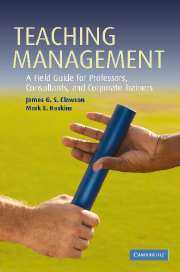Book contents
- Frontmatter
- Contents
- List of figures
- Sources to chapter quotations
- Why this book on teaching management?
- 1 Fundamental elements in teaching
- 2 Levels of learning: one, two, and three
- 3 Adult learning theory: it matters
- 4 Planning a course: trips and tips
- 5 Planning a class: no detail is too small
- 6 Lecturing: the possibilities and the perils
- 7 Managing discussions
- 8 Case method: fostering multidimensional learning
- 9 Role-playing
- 10 Case writing: crafting a vehicle of interest and impact
- 11 Case teaching notes: getting from here to there
- 12 Action learning
- 13 Experiential methods
- 14 Enhancing the conversation: audiovisual tools and techniques
- 15 Executive education: contributing to organizational competitive advantage
- 16 Using technology to teach management
- 17 Counseling students
- 18 Evaluating students: the twin tasks of certification and development
- 19 Teaching evaluations: feedback that can help and hurt
- 20 Research presentations
- 21 Managing a degree program: behind the ‘glory’
- 22 Managing a nondegree client program: an overview
- 23 Dealing with the press
- 24 Managing yourself and your time
- 25 Using teaching portfolios and course portfolios
- 26 Conclusion: is this on the exam?
- Index
13 - Experiential methods
Published online by Cambridge University Press: 25 February 2010
- Frontmatter
- Contents
- List of figures
- Sources to chapter quotations
- Why this book on teaching management?
- 1 Fundamental elements in teaching
- 2 Levels of learning: one, two, and three
- 3 Adult learning theory: it matters
- 4 Planning a course: trips and tips
- 5 Planning a class: no detail is too small
- 6 Lecturing: the possibilities and the perils
- 7 Managing discussions
- 8 Case method: fostering multidimensional learning
- 9 Role-playing
- 10 Case writing: crafting a vehicle of interest and impact
- 11 Case teaching notes: getting from here to there
- 12 Action learning
- 13 Experiential methods
- 14 Enhancing the conversation: audiovisual tools and techniques
- 15 Executive education: contributing to organizational competitive advantage
- 16 Using technology to teach management
- 17 Counseling students
- 18 Evaluating students: the twin tasks of certification and development
- 19 Teaching evaluations: feedback that can help and hurt
- 20 Research presentations
- 21 Managing a degree program: behind the ‘glory’
- 22 Managing a nondegree client program: an overview
- 23 Dealing with the press
- 24 Managing yourself and your time
- 25 Using teaching portfolios and course portfolios
- 26 Conclusion: is this on the exam?
- Index
Summary
Experience is the best teacher.
Experiential teaching methods are those that rely on data generated during the exercise/learning experience rather than on data prepared in advance as with lectures and cases. Experiential methods engage students in experiences that simulate social phenomena. They include games such as Starpower, Gazogle, Global Markets, Sub-Arctic Survival, and the Organization Game as well as computer simulations like Markstrat, Sentra, Cogitate, and CapSim. These exercises, and a host of others, are available worldwide for instructors to purchase and use.
By engaging students in simulations of business situations, experiential methods generate their own data for students to consider and digest. Unlike the case method, in which the case provides the information to deal with, and unlike the lecture where the instructor and the text provide the information, experiential methods establish a platform for students to generate their own information and then to analyze and use it. What a student analyzes and learns from is not the written introduction to the exercise, but what happens in the exercise itself. In this sense, the increasingly common outdoor exercises (often called “ropes courses” because many include rappelling or rope-bridge construction and use, etc.) also fit into the category of experiential exercises. And in a sense, role-playing, as described above, is a mini-experiential exercise embedded in a class the same way a lecturette can be embedded in a case discussion.
Michael Polanyi (1962) said that some kinds of knowledge are logically unspecifiable.
- Type
- Chapter
- Information
- Teaching ManagementA Field Guide for Professors, Consultants, and Corporate Trainers, pp. 212 - 227Publisher: Cambridge University PressPrint publication year: 2006



